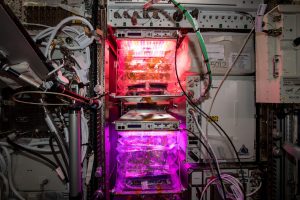
‘Red Robin’ dwarf tomato growing in Veggie hardware at the Kennedy Space Center. Image courtesy of NASA, ground study
The Dragon spacecraft carries scientific experiments and technology demonstrations that explore growing plants in space, creating nutrients on demand, in-space construction, and more. NASA Ames is working on nutrition research that aims to get humans closer to reaching Mars.
A continuous source of nutritious food is essential for long duration exploration missions, and the typical pre packaged astronaut diet may need to be supplemented by fresh foods produced in space.
Space tomatoes, portable diagnostic kits and yogurt bags growing beneficial microorganisms are just a sample of the innovations that will ride aboard SpaceX’s 26th commercial resupply mission, which is scheduled to take off for the International Space Station from NASA’s Kennedy Space Center in Florida on Tuesday (Wednesday, 23 November 2022 as per Indian time).
Researchers have been testing a plant growth unit on station known as Veggie and have successfully grown a variety of leafy greens.Veg-05, the next step in that work, and focuses on growing dwarf tomatoes.
NASA Space Crop Production Scientist Dr. Gioia Massa is sending tomato seeds up to the International Space Station to learn more about growing edible plants during space flight. The tomatoes will be grown in what are called plant pillows, essentially space grow bags, filled with ceramic substrate, vegetable production system like the one shown here.

“We are testing tomatoes, looking at the impacts of light spectrum on how well the crop grows, how delicious and nutritious the tomatoes are, and the microbial activity on the fruit and plants,” says Gioia Massa, NASA Life Sciences project scientist and VEG-05 principal investigator. “We also are examining the overall effect of growing, tending, and eating crops on crew behavioral health. All of this will provide valuable data for future space exploration.”
Massa expects crew members to make three harvests during the 100-day experiment, and they’ll be asked to rate the tomatoes for taste. Astronauts will also take surveys “to assess their moods and any psychological benefits that growing plants may have when they’re living and working in this extreme environment,” Massa added.
Due to the lack of gravity, “water sort of sticks to surfaces and crawls,” Massa said, “So it can be really challenging.”
“It’s porous, so it helps trap water and air into the roots of the plants,” Massa said. “That’s one of the strangest things about growing plants in space, is really the behavior of water and trying to water your plants.”
The supply also has a Moon Microscope kit for an in-flight medical diagnosis. It comprises a portable hand held microscope and a small self-contained blood sample staining device. In case of illness, an astronaut can collect and stain a blood sample, take images.
Also read: SpaceX To Launch Of Japanese Moon Mission
Nasa is sending liquid resin packed inside a Nanoracks Black Box to examine viability at in-space construction. “Our method reduces the time to produce key parts needed for daily mission use and it may support future space construction of large structures like trusses and antennae.” says Ariel Ekblaw, a scientist associated with Massachusetts Institute of Technology.
Weightlessness at the time of departure from Earth, the gravity of another planet, and Earth’s gravity in return journey. These transformations can disturb spatial orientation, head-eye and hand-eye coordination, balance, and locomotion. As we pursue future space exploration, astronauts need to be prepared for three different kinds of gravity fields. This can be dangerous for missions, as some crew members can be affected by space motion sickness.
Nasa is also sending second of three packages of Roll Out Solar Array technology. These solar panels roll out like a rug or a yoga mat by stored kinetic energy. Using this, ISS can expand its power-production capacities. The second set is expected to provide a 20-30% boost in energy for space station research and operations.

















